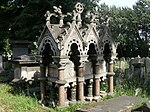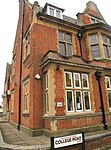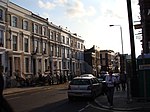Kensal Green Cemetery

Kensal Green Cemetery is a cemetery in the Kensal Green area of North Kensington in the Royal Borough of Kensington and Chelsea in London, England. Inspired by Père Lachaise Cemetery in Paris, it was founded by the barrister George Frederick Carden. The cemetery opened in 1833 and comprises 72 acres (29 ha) of grounds, including two conservation areas, adjoining a canal. The cemetery is home to at least 33 species of bird and other wildlife. This distinctive cemetery has memorials ranging from large mausoleums housing the rich and famous to many distinctive smaller graves and includes special areas dedicated to the very young. It has three chapels and serves all faiths. It is one of the Magnificent Seven cemeteries in London. The cemetery was immortalised in the lines of G. K. Chesterton's poem "The Rolling English Road" from his book The Flying Inn: "For there is good news yet to hear and fine things to be seen; Before we go to Paradise by way of Kensal Green."Despite its Grecian-style buildings, the cemetery is primarily Gothic in character, due to the high number of private Gothic monuments. Due to this atmosphere, the cemetery was the chosen location of several scenes in movies, notably in Theatre of Blood. The cemetery is listed Grade I on the Register of Historic Parks and Gardens. It remains in use.
Excerpt from the Wikipedia article Kensal Green Cemetery (License: CC BY-SA 3.0, Authors, Images).Kensal Green Cemetery
Central Avenue, London North Kensington (Royal Borough of Kensington and Chelsea)
Geographical coordinates (GPS) Address Nearby Places Show on map
Geographical coordinates (GPS)
| Latitude | Longitude |
|---|---|
| N 51.5286 ° | E -0.2241 ° |
Address
Central Avenue
Central Avenue
NW10 5BU London, North Kensington (Royal Borough of Kensington and Chelsea)
England, United Kingdom
Open on Google Maps







